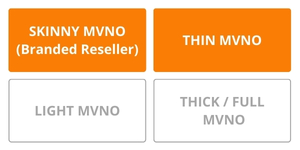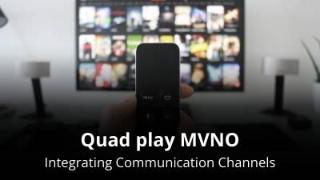Introduction about starting a Discount MVNO (Mobile Brands)
Discount MVNOs carve their niche by offering basic Voice, SMS and Data services at competitive rates, often targeting price-sensitive consumers.
Nearly a quarter of existing MVNOs have chosen the discount base MVNO model and their service offering usually includes basic Voice, SMS and Data services at lower tariffs for both prepaid and postpaid customers, adding to it the flavor of cheaper handset devices.
In terms of long-term sustainability the discount MVNO approach can prove to be very difficult since you are always competing on price, and the MNO can always do better.
What do you need to know about starting a Discount MVNO/IOT
- What are the advantages and disadvantages ?
- What are the Revenue sources and Pricing strategy?
- What are suitable segments?
- What kind of Mobile bundles are typically used?
- What kind of ARPU can you expect?
- What is the Go-to-Market Strategy?
- What are some points to think of for the Marketing Plan?
- What kind of financing is to be expected?
- What kind of MVNO type is typically used?
- What is the expected time for the launch?
- What is the expected impact of 5G?
- What is the expected impact of eSIM?
- IOT and its Relation to Discount MVNOs
- Benefits of Launching Discount MVNO/IOT
- Frequently Asked Question
- Summary
What are the advantages and disadvantages of Discount MVNOs/IOT?
Advantages: Discount MVNOs appeal to budget-conscious consumers, offering basic Voice, SMS and Data services at competitive rates. Their advantage lies in affordability, attracting price-sensitive demographics seeking reliable mobile services without hefty expenses.
Disadvantages: Sustaining profits in a competitive market with thin margins poses a challenge. Fierce price wars and evolving consumer demands require constant innovation to maintain a balance between affordability and quality service.
What are the Revenue sources and Pricing strategy?
Revenue Sources: Main revenue comes from prepaid and postpaid voice, SMS, and data services. Focuses on a high volume of customers to offset lower individual margins.
Pricing Strategy: Offers competitive, budget-friendly pricing to attract price-sensitive customers.
What are suitable segments/markets?
- Students: Providing affordable plans catering to students’ budget constraints.
- Older people: Tailoring plans for older people with simplified services and easy-to-use devices.
- Low-Income Families: Offering budget-friendly options for families seeking economical mobile services.
- Young Professionals: Providing basic services at lower tariffs for young professionals starting their careers.
- International Callers: Focusing on customers making frequent international calls with competitive rates.
- Travelers: Offering prepaid services with low roaming charges for travelers and tourists.
- Prepaid Users: Catering to individuals who prefer prepaid plans over postpaid contracts.
- Minimal Users: Providing simple voice and text services for users who don’t require data or extensive features.
- Non-Smartphone Users (yes, they do still exist): Offering plans suited for basic phones without the need for smartphone features.
- Secondary Phone Owners: Targeting customers seeking a secondary phone for specific purposes with affordable options

What kind of Mobile bundles are typically used for Discount MVNOs/IOT?
Data: Low to moderate demand for basic internet use, social media, and occasional app downloads. Use case: Checking emails, social media updates, light browsing.
Voice: Moderate demand for essential calls to family, friends, and work contacts. Use case: Casual conversations, arranging meetups.
SMS: Moderate demand for basic texting, notifications, and alerts. Use case: Sending texts, receiving promotions.
What kind of ARPU can you expect?
ARPU: Low to moderate.
Why: Discount MVNOs target price-sensitive customers who prioritize affordability over premium services. Their revenue comes from a large customer base with low-margin plans.
Where It Is Based On: This ARPU is based on offering basic voice, SMS, and limited data services at lower tariffs, attracting budget-conscious customers.
You need to work out the details in your Financial Plan.

What is the Go-to-Market Strategy for Discount MVNOs/IOT?

Aggressive online and offline marketing campaigns are essential. Utilize social media, influencers, and strategic partnerships to maximize reach. Focus on highlighting cost-effectiveness and reliability, ensuring potential customers understand the value proposition amid budget-friendly pricing.
- Target Audience: Budget-conscious consumers, students, and young adults seeking affordable mobile services.
- Pricing Strategy: Competitive pricing with emphasis on low-cost plans, discounts, and bundled services.
- Distribution Channels: Online platforms, retail partnerships, and kiosks in high-traffic areas.
- Promotion: Digital marketing, social media campaigns, and referral programs to attract new customers.
- Customer Support: Efficient online support, FAQs, and community forums for issue resolution.
What are points to think of for the Marketing Plan?
Leverages affordability as the primary selling point, often relying on online marketing, social media, and word-of-mouth to reach cost-conscious consumers. You need to work out below points in your Marketing Plan.
USP: Unbeatable low prices with reliable network coverage.
Content Creation: Create engaging content on social media highlighting savings, discounts, and testimonials
Promotions: Limited time offers, student discounts, and family plans to attract diverse customer segments.
Partnerships: Collaborate with universities, communities, and online forums frequented by budget-conscious consumers.
Feedback Loop: Regularly gather customer feedback to enhance service offerings and address pain points.

What kind of financing is to be expected for Discount MVNOs/IOT?

Financing: Moderate
Discount MVNOs primarily focus on low-cost services and affordable handsets. Initial investment is required for network infrastructure, marketing, and handset subsidies. However, the focus on low prices often means a thin profit margin, requiring careful financial management.
You need to work the details in your Financial Plan.
What kind of MVNO type is typically used for Discount MVNOs?
MVNO Type: Branded Reseller / Thin MVNO
Discount MVNOs primarily focus on low-cost services and affordable handsets.
Initial investment is required for network infrastructure, marketing, and handset subsidies. However, the focus on low prices often means a thin profit margin, requiring careful financial management. Important here is that you are ale to create your own (discount) bundles.
See also: Different types of MVNOs

What is the expected time to launch?

Expected Time to Launch: 3-6 months
Discount MVNOs, focusing on basic voice and SMS services, can leverage existing infrastructures, which expedites the launch process. The primary focus is on marketing strategies and customer acquisition.
You might be able to expedite the launch process with a specific Strategy: For example, focus on ready-made packages from MNOs, utilize their existing packages (bundles), and leverage their customer support services. Rapid market entry is achieved by simplifying services and tariff structures..
What is the expected impact of 5G for Discount MVNOs?
5G enables more cost-effective data delivery, allowing Discount MVNOs to offer higher data allowances without increasing prices significantly. Faster speeds enhance user experience, attracting more customers seeking budget-friendly, high-speed services. For more details see the Mobile Network section.

What is the expected impact of eSIM for Discount MVNOs?
IOT and its Relation to Discount MVNOs
While Discount MVNOs primarily focus on providing basic mobile services at the lowest possible cost, IoT can still play a role in enhancing their offerings and attracting price-sensitive customers. The key is to focus on simple, cost-effective IoT solutions that provide tangible value without significantly increasing costs. Here’s how Discount MVNOs can leverage IoT:
Usage Monitoring and Data Optimization: IoT can help customers monitor their data usage in real-time and avoid overage charges. Simple data tracking apps or widgets can be integrated into the MVNO’s platform, providing users with clear insights into their consumption patterns. This can be particularly appealing to budget-conscious customers who are concerned about unexpected costs.
Device Management and Security: Basic device management and security features can be offered through IoT integration. For example, remote device locking or data wiping capabilities can be valuable for customers who are concerned about device theft or loss. These features can be offered at a low cost or even bundled with basic mobile plans.
Location-Based Services for Deals and Discounts: Location-based services can be used to notify customers about nearby deals and discounts from partner businesses. This can be a valuable way to add value to the MVNO’s offering without incurring significant costs. For example, customers could receive notifications about discounts at local restaurants or stores when they are in the vicinity.
Connected Home Security and Monitoring (Basic): Discount MVNOs could partner with providers of basic connected home security or monitoring solutions to offer bundled packages. This could include simple features like remote door lock control or basic motion detection. These offerings could appeal to budget-conscious customers who are looking for affordable home security solutions.
Simple Tracking and Asset Management: For customers with basic tracking needs, such as keeping track of keys, luggage, or pets, Discount MVNOs could offer affordable tracking devices and services. These devices could utilize low-cost connectivity solutions like narrowband IoT (NB-IoT) to minimize costs.
Focus on Affordability and Simplicity: The key for Discount MVNOs is to focus on affordability and simplicity when integrating IoT. They should avoid complex or expensive solutions and prioritize those that provide clear value to price-sensitive customers. This could involve partnering with providers of low-cost IoT devices and platforms or focusing on basic features that can be easily integrated into their existing offerings.
By focusing on simple, cost-effective IoT solutions, Discount MVNOs can enhance their offerings and attract budget-conscious customers without compromising their core value proposition of affordability.
Benefits of Launching Discount MVNO/IOT
Cost-Conscious Appeal: Attract price-sensitive customers by offering stripped-down plans with lower monthly fees. This caters to budget-minded users who prioritize affordability over extensive features.
Flexible Top-Ups: Provide convenient top-up options for data or minutes, allowing users to control their spending and avoid exceeding their plan limits. This caters to users with unpredictable usage patterns.
Focus on Value: Highlight the cost savings associated with your MVNO plans compared to major carriers. This transparency and focus on value will resonate with customers seeking the most affordable option.
Partnerships for Added Benefits: Partner with discount retailers or budgeting apps to offer additional benefits like cashback rewards or exclusive discounts on purchases when using your MVNO service.
Smart Home Security Bundles: Partner with smart home security providers to offer bundled packages that include discounted mobile connectivity and IoT security devices, appealing to budget-conscious consumers looking for home protection.
Usage-Based Insurance for Connected Cars: Offer partnerships with insurance companies for usage-based insurance programs that leverage connected car data to provide discounts based on driving behavior.
Frequently Asked Questions
1. How can a Discount MVNO effectively balance affordability with quality service to attract and retain customers in a competitive market?
Answer: Balancing affordability with quality service is crucial for a Discount MVNO to attract and retain customers in a competitive market. By leveraging existing infrastructure and focusing on low-cost plans, the MVNO can offer basic voice, SMS, and data services at competitive rates. Emphasizing reliability and network coverage while highlighting cost-effectiveness in aggressive marketing campaigns ensures potential customers understand the value proposition amid budget-friendly pricing.
2. What strategies can a Discount MVNO employ to differentiate itself from competitors and maximize market penetration?
Answer: To differentiate itself, a Discount MVNO can leverage partnerships, online marketing, and strategic pricing. By targeting price-sensitive demographics such as students and low-income families, the MVNO can tailor affordable plans and offer discounted handset devices. Aggressive online and offline marketing campaigns, coupled with strategic partnerships with universities and communities, maximize reach and enhance brand visibility. Additionally, limited-time offers, student discounts, and family plans attract diverse customer segments, maximizing market penetration.
3. What financial considerations are involved in launching and sustaining a Discount MVNO, and how can they be effectively managed?
Answer: Launching and sustaining a Discount MVNO require careful financial management due to thin profit margins. Initial investment is needed for network infrastructure, marketing, and handset subsidies. However, focusing on low-cost services and affordable handsets can mitigate risks and ensure financial sustainability. By leveraging existing infrastructures, ready-made packages from MNOs, and customer support services, the MVNO can expedite the launch process and minimize costs. Additionally, monitoring expenses, optimizing pricing strategies, and maximizing operational efficiency are crucial for long-term success.
4. How can a Discount MVNO capitalize on emerging technologies like 5G and eSIM to enhance its service offerings and attract new customers?
Answer: Emerging technologies like 5G and eSIM present opportunities for Discount MVNOs to enhance service offerings and attract new customers. With 5G, the MVNO can offer higher data allowances without significantly increasing prices, leveraging faster speeds to enhance user experience. This attracts more customers seeking budget-friendly, high-speed services. Additionally, eSIM technology simplifies onboarding processes for prepaid customers, allowing instant activation and plan selection directly from devices. This streamlines onboarding costs and enhances customer convenience, contributing to increased market penetration and customer acquisition.
5. What strategies can Discount MVNOs employ to sustain profitability in a competitive market with thin margins?
Answer: Discount MVNOs can employ several strategies to sustain profitability in a competitive market with thin margins. Firstly, they can focus on cost optimization by negotiating favorable terms with network operators, streamlining operational processes, and investing in efficient customer support systems. Additionally, Discount MVNOs can differentiate themselves by offering value-added services such as loyalty programs, bundled offerings, and innovative pricing structures. By continuously monitoring market trends and consumer behavior, Discount MVNOs can identify new revenue opportunities and adapt their business models accordingly. Furthermore, strategic partnerships with device manufacturers, content providers, and other telecom companies can help Discount MVNOs enhance their service offerings and attract a larger customer base. Finally, investing in marketing and branding initiatives to increase brand awareness and customer loyalty can contribute to long-term profitability and sustainability for Discount MVNOs.
Summary
In summary, Discount MVNOs/IOT play a vital role in making mobile phone service accessible to budget-conscious consumers. By targeting specific demographics and offering competitive rates for basic phone services, they cater to a significant market segment. However, navigating the fiercely competitive discount mobile market and turning a profit requires careful planning and strategic execution.



















